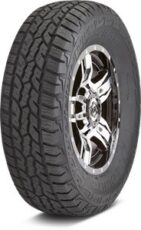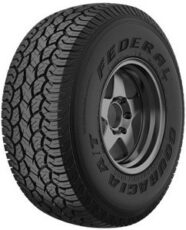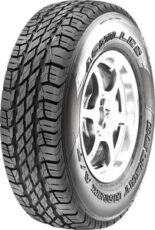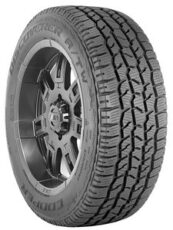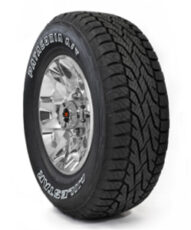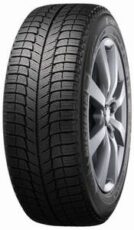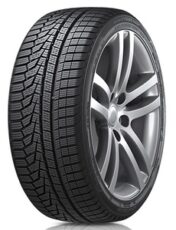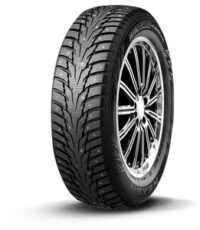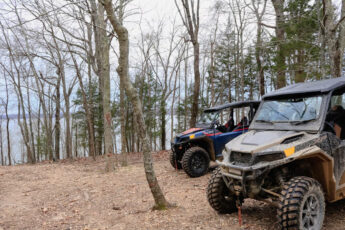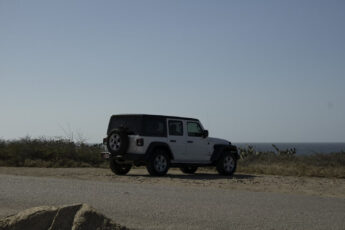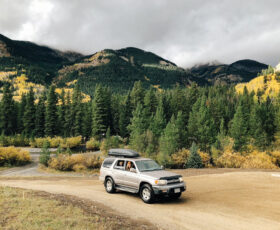Last Updated on 4 months
Exploring the Pros and Cons of All-Terrain Tires in Winter Conditions
As winter approaches, truck and SUV owners and commuters worldwide are looking to equip their vehicles with the most capable tires to get through the season. A common topic we see this time of year is deciding which types of tires are best: winter tires or all-terrain tires.
Both have rugged designs and constructions meant to handle harsh conditions.
High-quality tires are one of the best ways to ensure that your vehicle is safe to drive on the roads, no matter what type of weather or terrain lies ahead. A dedicated winter tire is the best choice for some people, while some light truck owners benefit far more from an all-terrain model.
1. All-Terrain Tires
All-terrain tires are made to provide truck and SUV drivers (not passenger car drivers) with traction on all surfaces – ranging from pavement to gravel to mud. They are designed to be an all-in-one model for people driving light trucks on multiple surfaces.
Not every all-terrain tire is designed for winter conditions. This capability will largely depend on the M+S or Three-Peak Mountain Snowflake Rating. With these features, all-terrain tires can be a good choice in winter.
Three-Peak Mountain Snowflake Symbol – Distinguishes tires with solid levels of winter traction, which have passed the “severe snow service” test by the Rubber Manufacturers Association (RMA).
M+S Symbol – Distinguishes tires that can perform in a basic level of mud and snow.
Tires these days can come with both symbols.
Features of All-Terrain Tires
All-terrain tires, or just “AT tires,” are built for excellent pavement performance with moderate off-road capabilities. They are often ideal for camping vehicles, hunting, work trucks, and farming trucks. AT tires are also for everyday drivers who occasionally drive on gravel, turf, or dirt roads.
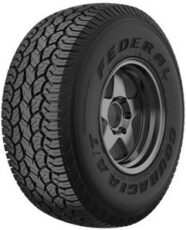 AT tires have tighter tread patterns to perform on paved roads, yet have unique designs and siping capabilities for off-road traction.
AT tires have tighter tread patterns to perform on paved roads, yet have unique designs and siping capabilities for off-road traction.
Where Do All-Terrain Tires Work Best?
Since these are an all-in-one type model, all-terrain tires are generally suitable for driving in multiple conditions, including:
- Paved roads
- Light snow and ice
- Sand
- Gravel roads
- Dirt roads
- Rocky terrain
- Wet surfaces
But as the saying goes, “a jack of all trades is a master of none.”
Now, the technology in all-terrain tires has come a long way. Most models will do a fine job on each terrain type, but you must be careful to choose an all-terrain tire equipped for winter driving, as the compounds on some all-terrain models may weaken during extreme cold bouts.
If you plan off-road driving during the cold winter months, an all-terrain tire model with an M+S rating or Three-Peak Mountain Snowflake will be a good choice.
Vehicles that May Need All-Terrain Tires
Some vehicle manufacturers recommend all-terrain tires. This is most commonly seen on larger vehicles, like trucks, SUVs, and some CUVs – never small passenger cars.
Not ALL trucks, SUVs, or CUVs will require all-terrain tires during the winter. Much of this decision comes down to the individual driver’s situation. A good all-terrain tire with winter ratings will be ideal if you live in a climate that experiences winter conditions and commonly drives on unpaved roads.
On the other hand, if you never (or rarely) drive on unpaved roads, a designated winter tire might be the better option.
Pros and Cons of All-Terrain Tires
All-terrain tires have many benefits. However, not all of them are ideal for every winter circumstance.
Let’s review some of AT tires’ significant pros and cons.
Pros
- Year-Round Operability – On a convenience level, you won’t need to switch out your all-terrain tires multiple times each year, depending on the terrain you drive on.
- Massive Selection of Budget-Friendly Models – All-terrain tires are top-rated. That being said, many options exist that don’t have to break the bank! You can find some of the best all-terrain tires for under $200 and plenty of quality options for under $100.
- Strong Reinforced Sidewalls – Since the sidewalls of AT tires are stiffer than a traditional tire, they can withstand more wear and tear and will not easily get scratched or damaged by debris. Additionally, this adds load-carrying capacity.
Cons
- Noise—One common complaint about all-terrain tires is that they can be loud due to their thicker rubber construction and tread block patterns.
- Lower Fuel Efficiency – The aggressive design of all-terrain tires slightly compromises fuel efficiency, as there is greater mechanical friction and rolling resistance. The good news is that the technology on many of the newer models has dramatically improved fuel efficiency.
- Shorter Tread Life – Many all-terrain tires have a slightly shorter tread life than a typical all-season tire. AT tires can last anywhere from 40,000 to 70,000 miles before they need to be replaced. When looking into the top all-terrain tire models, the lifespan will depend on the quality and the manufacturer’s focus on long wear.
Best All-Terrain Tires
Ironman All Country A/T:
This tire’s wide-angled grooves make it a top choice for pick-up trucks that occasionally drive off-road. The thick tread blocks provide durability and grip on wet and dry surfaces.
Equipped with an M+S rating, this tire will work well in wintry conditions.
Pricing for this model starts at $135.15/tire.
Federal Couragia A/T:
This all-terrain tire is designed for a smoother, quieter ride, with the latest silica tread compound for optimal handling and high performance on mud and light snow.
Pricing for this model starts at $87.64/tire.
Achilles Desert Hawk A/T:
This budget-friendly option is for light truck drivers driving occasionally drive off-road. The staggered tread pattern provides excellent handling on highways, dirt paths, soft mud, and snow.
Pricing for this model starts at $76.59/tire.
Cooper Discoverer A/TW:
This all-terrain type is also designed for year-round driving, so you can take it through light snow and ice and on hot paved roads in the summer. Its tread pattern helps to expel dirt, rocks, and water, and the large tread blocks give more robust traction in loose terrain.
Pricing for this model starts at $77.99/tire.
Milestar Patagonia A/T:
This all-terrain tire is designed for superior performance on snow and ice, making it a tremendous all-terrain choice for winter driving. It is designed to vent heat through the ribs and tread blocks, keeping the tire pliable for better grip on cold roads.
Pricing for this model starts at $71.27/tire.
2. Winter Tires
Snow and winter tires are designed for paved roads during the cold months.
Before diving in, let’s quickly discuss the difference between snow and winter tires.
Technically speaking, “snow tires” refer to a more traditional style. These tires aren’t widely produced anymore, as the designs are outdated.
The traditional styles of snow tires were designed for performance on snowy roads with big lugs/tread blocks. The main drawback was that they didn’t perform exceptionally well in frigid temperatures. This can be attributed to the lack of tire technology that we have today.
The modern iterations of winter tires are built for whole-package performance on snow, ice, and sub-zero temperatures – thanks to engineered rubber compounds, highly specialized tread patterns, and high sipe density. The sipes on these tires are technologically designed for excellent grip in wintry conditions.
Additionally, winter tires are designed for fuel economy, low noise levels, comfort, and pliability as the temperature drops.
Features of Winter Tires
The rubber compounds in the tread are built to stay flexible in below-freezing temperatures to provide sufficient traction during treacherous winter driving conditions. This gives the winter tire a firmer grip on the roads to prevent slipping or hydroplaning.
Winter tires commonly have biting edges on the tread, which create extra grip on packed snow and ice. They also have advanced siping patterns for further traction in all winter road conditions.
What Types of Terrain do Winter Tires Perform Best On?
The best winter tires are designed for roads covered in snow and ice. They are best when driven on highways with hard-packed snow, like what is left after it has been plowed.
Winter tires are designed for driving on paved roads. They will not do well in off-road conditions, as they are not designed with the off-road characteristics of all-terrain or specific terrain tires.
Types of Winter Tires
There are three main categories of winter tires.
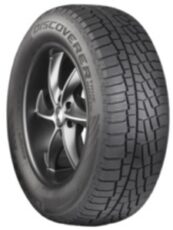 Non-studded Winter Tires: These tires use advanced rubber compounds and tread designs instead of metal studs to provide ice traction. They feature a deep tread pattern with sipes for better control on cold or icy roads. As winter tire technology advances, non-studded winter tires are becoming more preferred.
Non-studded Winter Tires: These tires use advanced rubber compounds and tread designs instead of metal studs to provide ice traction. They feature a deep tread pattern with sipes for better control on cold or icy roads. As winter tire technology advances, non-studded winter tires are becoming more preferred.
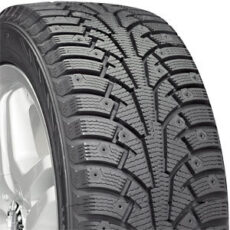
- Studdable: This tire is designed so that metal and plastic studs can be installed for additional traction during extremely icy driving conditions. Otherwise, this tire has similar features to traditional winter models.
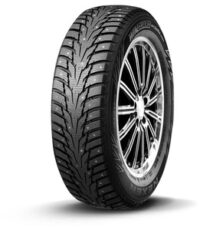 Studded: These tires have metal or hard plastic studs within the tread that dig into ice. These studs are great for griping icy roads but can damage the pavement without ice. Some states limit this type of tire use – and some have even outlawed them.
Studded: These tires have metal or hard plastic studs within the tread that dig into ice. These studs are great for griping icy roads but can damage the pavement without ice. Some states limit this type of tire use – and some have even outlawed them.
Pros and Cons of Winter Tires
Winter tires indeed come with a fair share of advantages – and disadvantages.
Let’s go over the big ones.
Pros
- Excellent Performance on Snow and Ice – Obviously, extra grip on snowy and icy roads is the most significant benefit of having winter or snow tires. These tires are designed to give drivers the best control when the roads are slickest.
- Maintains Grip in Extreme Cold—Winter tires are made with a specialized rubber compound that stays soft when the temperature drops to extreme cold. A standard tire stiffens in the cold, reducing its ability to grip and provide traction. Winter models stay more pliable.
- Excellent Handling – Winter tires are known for exceptional handling on slippery roads. The top winter tires also have features that offer a quiet, smooth ride and, when used properly, have a long-lasting tread life.
Cons
- Not Meant for Year-Round Driving – For those who don’t live in the Arctic Circle, one apparent downside to winter tires is that they should only be used during the colder months. If you drive on winter tires after the temperatures rise, it will cause the rubber to wear down at a faster pace, and you will have compromised traction. To get the most out of your winter tires, you will need to purchase separate tires for the warmer months and have them switched out.
- Cost – Good winter tires can be expensive. The good news is that you can find some high-quality models reasonably priced.
- Designed for Paved Roads—Winter tires are designed only for driving on paved roads. They are not optimized for off-road driving, perhaps the most significant thing to consider when buying winter tires versus all-terrain tires.
Best Winter Tires
Here are some of the highest-rated winter tires offered at Giga Tires.
Firestone Winterforce 2:
This winter tire is designed for light trucks and SUVs and comes in non-studded and studdable options. It is best for light trucks and SUVs driving in deep snow or ice, as the tread blocks have sipes for extra grip on slippery surfaces.
Pricing for this model starts at $121.10/tire.
Cooper Evolution Winter:
This studdable winter tire comes in multiple sizes to fit most passenger vehicles and SUVs and is designed for superior performance in deep snow. The tread pattern design maintains stability in winter conditions, and studs can be added for driving on icy, slick roads.
Pricing for this model starts at $61.57/tire.
Michelin X-Ice X13:
Michelin is a highly trusted tire brand. This model is designed for the safest driving on snowy, icy, and wet roads. Even more, the X-Ce tire is made to provide a higher fuel efficiency than other winter tires.
Pricing for this model starts at $85.06/tire.
Hankook Winter I-Cept Evo2 W320:
Hankook is one of the most budget-friendly tire brands – that doesn’t skimp on quality. Thanks to its asymmetric tread pattern for optimized performance and handling, this tire is designed for treacherous winter driving in touring sedans and sports cars.
Pricing for this model starts at $213.60/tire.
Nexen Winguard Winspike:
This studded tire enhances performance on extremely icy roads. It has a V-shaped tread pattern that quickly expels water and slush for maximum grip, and the center rib block design keeps the tire stable on cold and wet roads.
Pricing for this model starts at $44.52/tire.
Key Differences Customers Must Know
When considering the next set of tires to purchase, you must feel the model that will keep you and your passengers safe. This is mainly dependent on the driving you will be doing.
When it comes to winter tires versus all-terrain tires, some notable differences to be aware of are:
Temperature:
All-terrain tires are best in mild temperatures that are neither hot nor cold. Winter tires are made specifically for colder temperatures and are not recommended for driving in warmer conditions.
Ratings:
Both winter and all-terrain tires offer models specifically designed for driving in unique conditions. Almost all-terrain tires have an M + S rating, which means they are suitable for driving in mud and snow. Some come with a Three-Peak Mountain Snowflake rating, which has been tested for driving in severe winter conditions.
Traction on Snow:
All-terrain tires are made of rubber that is less flexible or pliable in frigid temperatures than winter tires.
This will reduce traction on snowy roads; the tread blocks can sometimes become stiff and not provide optimal grip on ice. If you plan on driving through snow and ice (mostly on paved roads), a winter tire is the best option.
Conclusion
The type of tire you choose depends on several factors, including your vehicle’s requirements and the driving conditions. Even the best-rated all-terrain tires’ performance can pale compared to a winter tire on snowy roads. However, a winter tire is not the best for off-road driving.
Choosing between winter and all-terrain tires can be critical for your vehicle’s performance in various conditions. We’ve explored the pros and cons to help you make the right choice. Whether you prefer the specialized grip of winter tires in icy weather or the versatility of all-terrain tires for year-round use, the decision ultimately depends on your specific driving needs.
Ready to equip your vehicle with the perfect all-terrain tires for your adventures?
Visit Giga Tires today and explore our wide selection of all-terrain tires. Make the right choice for your vehicle and ensure you’re prepared for all road conditions. Your journey begins with the right tires from Giga Tires!
Here at Giga Tires, we have tire experts able to answer any questions about any tire type and point you in the right direction for a model that fits your needs and budget. Feel free to get in contact or browse around our collection to find a tire that will suit your needs!
Continue your journey of tire education with Giga Tires. Please explore our website for many articles to fuel your tire knowledge.
- Unlock Studded Vs Studdable Vs Non-Studded Winter Tires: Which 1 Is Right For You?
- Guide To Winter Tires: Top 5 Winter Tire Safety Tips
- Spotlight On GBC ATV Tires: The Admirable Innovation In ATV & UTV Tires
FAQs
Which is better, all-terrain or winter tires?
The choice between all-terrain and winter tires depends on your specific driving needs and the prevailing weather conditions in your area. Winter tires are designed for cold, snowy, and icy conditions, offering superior grip and traction in these challenging environments. On the other hand, all-terrain tires provide versatility for a broader range of conditions, including some light winter conditions.
Dedicated winter tires are better for safety and performance if you primarily encounter severe winter weather. However, if you face mixed or milder winter conditions and also require off-road capability, all-terrain tires can be a more practical choice.
Can all-terrain tires be used in winter?
Yes, all-terrain tires can be used in winter conditions to some extent. They are designed with a tread pattern that offers better traction on various surfaces, including snow and slush.
However, it’s important to note that all-terrain tires are less effective than dedicated winter tires in severe winter conditions. If you live in an area with harsh winters, with heavy snow and ice, using actual winter tires for maximum safety and performance is recommended.
What are the disadvantages of all-terrain tires?
While all-terrain tires offer versatility, there are some disadvantages to consider. They may not perform as well as dedicated tires in extreme conditions, such as deep mud or heavy snow. All-terrain tires are less fuel-efficient and produce more road noise than street-oriented tires. Additionally, their tread life might be shorter if used primarily on pavement.
Which is better, all-terrain or all-weather tires?
The choice between all-terrain and all-weather tires depends on your driving habits and the weather conditions you typically encounter. All-terrain tires are ideal for those who require off-road capability and experience various road conditions, including occasional light winter conditions. On the other hand, all-weather tires are designed to provide year-round performance in regions with mild winters.




